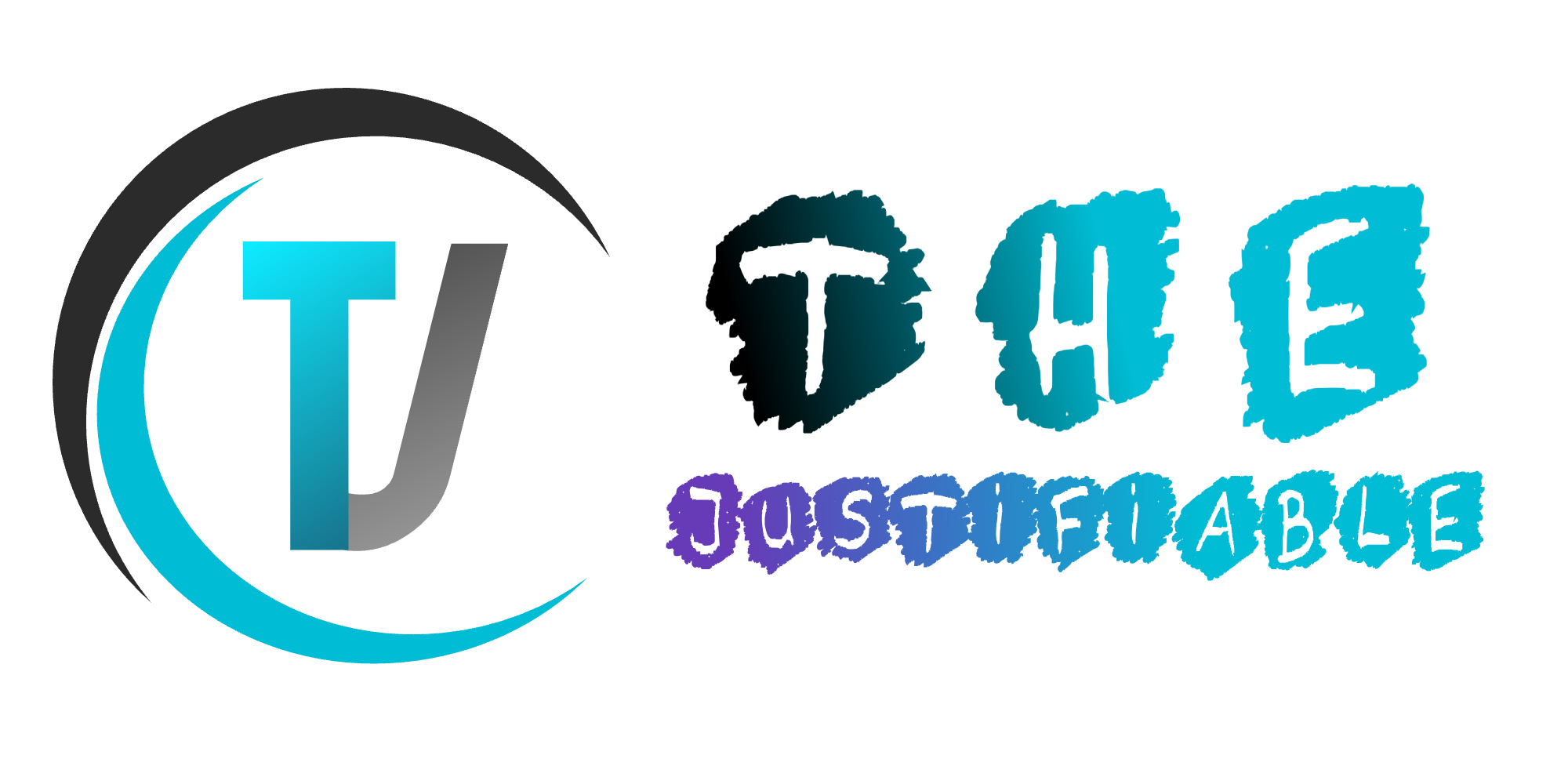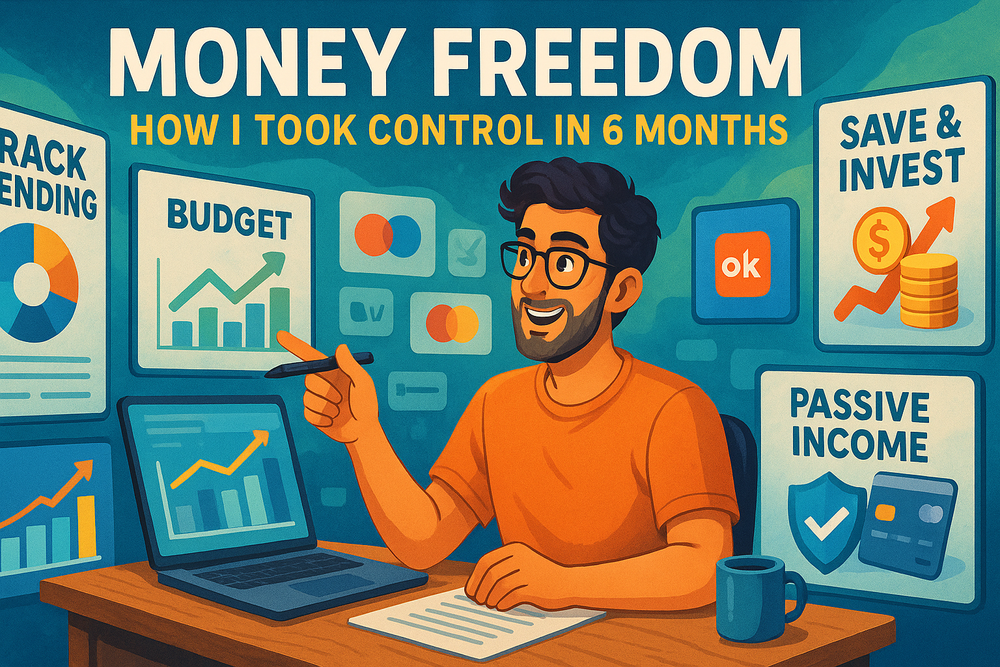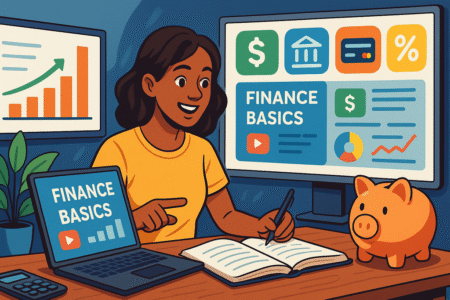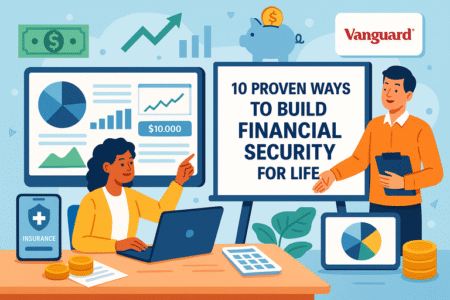Table of Contents
Money freedom isn’t just a dream—it’s something I achieved in just six months. What if you could stop stressing about every bill, ditch debt for good, and finally have money working for you instead of the other way around?
What steps actually move the needle fast? And how do you stay motivated without getting overwhelmed or burnt out?
In this post, I’ll walk you through exactly how I took control of my finances in half a year. From income hacks and cutting expenses to rewiring my mindset around spending, every move I made had one goal: total financial control and peace of mind.
If you’re ready to make serious changes and want a real-world blueprint to follow, you’re in the right place.
Defined My Version of Money Freedom With Crystal Clarity
Before making any changes, I had to be brutally honest with myself: what does money freedom actually mean to me? It wasn’t just about having a big bank balance—it was about how I felt waking up every day.
Financial goals are meaningless unless they’re built around your life, not someone else’s idea of success.
Asked What Freedom Actually Looked Like for Me
I started by asking one powerful question: If I had complete financial freedom, what would my life look like day to day? My answer wasn’t flashy. I wanted to cover my bills without stress, take weekend trips without guilt, and work only with clients I actually liked. For you, it might be different—and that’s the point.
Instead of copying someone else’s money goals, I sketched out my personal version of freedom:
- No credit card debt.
- $10,000 emergency cushion.
- Flexible schedule with remote freelance income.
- The ability to say “yes” to last-minute travel or family time.
Once I put this into words, every decision became easier. If something didn’t move me closer to that picture, I cut it.
Calculated My “Freedom Number” Based on Real Expenses
Then came the math. I reviewed the last 3 months of bank statements to get an honest snapshot. I added up everything—not just rent and groceries, but random Amazon splurges and impulse delivery orders. My goal? Find the bare minimum monthly income I needed to live comfortably and fund my freedom goals.
Here’s the simple formula I used:
Monthly Essentials + Financial Goals + Buffer = Freedom Number
My breakdown looked like this:
| Category | Amount (USD) |
| Rent & Utilities | $1,200 |
| Food & Essentials | $450 |
| Transportation | $150 |
| Minimum Debt Payments | $400 |
| Emergency Fund Saving | $300 |
| Total Freedom Number | $2,500 |
Once I saw that number, it stopped being this vague “someday” dream. It became a target I could actually hit.
Identified What I Needed to Stop Spending On
This part was uncomfortable. I realized I was leaking money through emotional spending. I was buying comfort after bad days, “treating myself” with takeout, and constantly chasing the next dopamine hit with little Amazon purchases.
Here’s how I cleaned it up:
- Unsubscribed from promo emails that triggered spending.
- Deleted food delivery apps for a month.
- Put a 48-hour rule on anything over $25.
I didn’t go full minimalist. I just got clear on what spending habits were actually costing me freedom—and gave myself permission to let them go.
Set Milestones With Dates—Not Just Vague Dreams
Once I had my vision and number, I reverse-engineered my path. I picked milestones I could track monthly, not just at the end. Instead of saying, “I’ll be financially free one day,” I set goals like:
- “Have $1,000 in savings by March 1.”
- “Cut $300 in expenses by end of January.”
- “Pay off credit card #1 by April 10.”
Each goal had a specific date, and I set calendar reminders to check in. This made the process feel real, grounded, and doable—not just wishful thinking.
Built a Bulletproof Budget That Matched My Life Goals

Once I knew where I wanted to go, I had to build a system that supported it daily. I’d failed at budgeting before because I treated it like a punishment. This time, I made it flexible, personal, and purpose-driven.
Created Buckets for Survival, Growth, and Joy
Instead of micro-managing every single dollar, I grouped spending into three main categories:
- Survival: rent, food, insurance, minimum debt payments.
- Growth: savings, investing, tools that make me money.
- Joy: fun, travel, takeout, subscriptions I love.
This approach gave me structure without feeling restrictive. I wasn’t just budgeting to survive—I was budgeting to live. Even when money was tight, I always made space for a small “joy” bucket to stay motivated.
Ditched Traditional Budgeting Apps That Didn’t Fit Me
I tried apps like Mint and YNAB, but they overwhelmed me with data I didn’t actually use. What worked? A custom Google Sheet I built in 30 minutes. It gave me just enough structure without the noise.
Key tabs I included:
- Income & expenses by category.
- Monthly goals and progress bar.
- Savings tracker with visual goals.
If you’re someone who avoids spreadsheets, try something like Tiller Money, which links to your bank but lets you customize your own layout in Google Sheets.
Switched to a Zero-Based System for Total Control
The biggest shift came when I adopted a zero-based budget. That means every dollar has a job—even if that job is just “fun” or “buffer.”
Here’s how it worked:
- At the start of the month, I looked at expected income.
- I allocated every dollar until I hit zero.
- Unexpected expenses didn’t break me—I just shifted buckets.
This method forced me to be intentional. I couldn’t “accidentally” overspend without facing it head-on.
Used Weekly Check-ins to Catch Overspending Early
Instead of reviewing my budget once a month (too late!), I made it a Sunday ritual to check in weekly. I’d spend 15 minutes reviewing:
- How much I spent in each bucket.
- What went off track—and why.
- One small tweak to get back on course.
These micro-adjustments made a massive difference. One week, I caught myself spending $60 on coffees and snacks. The next week, I brought my own and redirected that money to debt.
Pro Tip: Don’t try to overhaul everything at once. Build a budget that fits your life, not a spreadsheet fantasy. Money freedom doesn’t come from perfection—it comes from progress you can actually sustain.
Increased My Income Without Burning Out
To reach money freedom faster, I knew I had to boost my income—but I wasn’t about to sacrifice my health or work-life balance to do it. I took a calm, focused approach that fit my energy levels, time, and skills.
Turned My Existing Skills Into Freelance Services
Instead of learning something completely new, I doubled down on what I already knew: writing, editing, and basic design. I packaged these into simple freelance offers and started small. My first client was someone I’d already helped informally—and that one gig snowballed.
Here’s how I figured out what I could offer:
- Listed skills I used in previous jobs or hobbies.
- Asked friends what they’d pay me to help with.
- Created 2–3 “starter packages” that were easy to deliver.
For example, I offered blog editing for $50 per post or Canva templates for small businesses. These were low-effort but valuable services that didn’t burn me out.
Mini Case Study: After offering basic copyediting to a contact on LinkedIn, I landed a $400/month retainer. That client referred two others over the next two months. I never even built a portfolio—I just showed I could deliver.
Used Job Boards and LinkedIn Strategically
I didn’t waste time applying to everything. Instead, I set alerts on sites like FlexJobs, Upwork, and We Work Remotely for keywords like “freelance writer” or “remote design.” I applied only to jobs that matched my rates and skills exactly.
On LinkedIn, I optimized my headline to include the words “freelance” and “available for hire.” Then, I posted twice a week sharing short tips or wins related to my work. This built credibility without hard selling.
Tips that worked:
- Applied to 3–5 curated job leads per week.
- Kept a “done-for-you” intro pitch ready to tweak and send.
- Followed people in my industry and replied thoughtfully to their posts.
Negotiated Better Rates From Existing Clients
I realized I didn’t need more clients—I just needed to get paid more by the ones I had. After 1–2 months of consistent delivery, I started gently raising rates.
Here’s what I said:
“I’ve loved working with you and wanted to give a heads-up that my new rate for similar projects will be $X starting next month. I’m still happy to offer the same quality (or better), and I’ve got space to keep supporting you.”
Surprisingly, most said yes. Why? I was easy to work with and reliable—qualities that are hard to find.
A few lessons:
- Clients value consistency over perfection.
- Raising rates by 15–25% is often acceptable if you’ve built trust.
- Always give at least two weeks’ notice before a rate change.
Built a Small Digital Product for Passive Income
This part scared me at first—but it ended up being the most fun. I created a simple digital product: a budgeting spreadsheet that helped freelancers track income, taxes, and expenses. I listed it on Gumroad with a short video demo and sold my first five copies within a week.
Why it worked:
- It solved a specific problem I had already overcome.
- It was priced accessibly at $12.
- It came with a short walkthrough to reduce friction.
I didn’t get rich overnight, but those small wins added up. Over three months, I earned around $300 from the sheet alone—money I didn’t have to actively work for.
Passive Income Tip: Start small. Don’t build a course or ebook just yet. A 1-page template or checklist can be enough to launch.
Cut Recurring Expenses That Were Silently Draining Me
I wasn’t aware of how many small charges were quietly stealing from my freedom. Once I got serious about auditing my expenses, I found over $400/month in savings—without giving up anything important.
Audited Subscriptions and Monthly Bills Line by Line
I exported 90 days of transactions and scanned for every recurring charge. The results were wild:
- $12 for a streaming service I hadn’t used in months.
- $35 for a “free trial” I forgot to cancel.
- $49 monthly software I wasn’t using.
I made three lists:
- Keep and use regularly
- Cancel immediately
- Pause and reassess in 30 days
After canceling or pausing half of them, I felt an immediate mental lift—not just financial. Fewer subscriptions meant fewer distractions and fewer emails begging me to log back in.
Renegotiated My Rent and Utility Costs
This part took some guts, but it paid off. I called my internet provider, explained I was evaluating all my bills, and asked what options were available. They cut my monthly rate by $25 with zero pushback.
Then I emailed my landlord with a polite message:
“Given the current rental climate, I’d love to explore whether there’s any flexibility in my lease renewal terms. I’m a reliable tenant and would love to continue living here.”
That message got me a $50/month reduction—because I asked.
Tips that helped:
- Always ask to “review the account” instead of canceling.
- Check utility websites for budget billing or loyalty discounts.
- Use scripts like the ones on AskTrim.com or Rocket Money.
Switched Insurance and Cut Bank Fees
I compared auto and renter’s insurance using Policygenius and ended up switching providers. That saved me $18/month. I also moved from a big-name bank to a credit union that offered:
- No overdraft fees
- No minimum balance
- Free ATM network
The result? I stopped getting hit with $30 “surprise” fees that always came at the worst time.
Adopted the “No Annual Fee” Rule for Credit Products
Credit cards can be helpful tools—but not when they cost you $95 or $199 just to exist. I reviewed every card I had and closed any with high annual fees that weren’t earning me real value. Then I stuck with one no-fee cashback card that I paid off weekly.
Here’s the filter I use before applying for any financial product now:
- Does it charge a fee just for owning it?
- Can I get 80% of the value elsewhere for free?
- Will this simplify or complicate my system?
Since making these changes, I’ve avoided over $300/year in unnecessary fees.
Pro Tip: Recurring expenses often fly under the radar because they’re small—but they add up fast. Schedule a monthly “money cleanup” day to review everything. The goal isn’t to live with less—it’s to spend on what matters and cut what doesn’t.
Created Multiple Accounts to Separate My Money

Once I started earning more and managing expenses better, the next challenge was clarity. I needed a system that showed me exactly where my money was going—without guesswork or daily math. So I built a simple structure using multiple accounts, each with its own job.
Opened Separate Checking for Bills, Spending, and Income
I started by splitting my main checking account into three:
- Income Account: Where all client payments and deposits land.
- Bills Account: Used only for fixed monthly costs like rent, utilities, and subscriptions.
- Spending Account: For day-to-day use like groceries, coffee, and gas.
This alone changed everything. No more wondering whether I could afford a splurge or worrying about overdrafts from overlapping payments. If the spending account was low, I stopped spending. If bills were coming due, I knew the funds were already set aside.
Here’s a visual snapshot of the flow:
| Account Type | Purpose | Example Uses |
| Income | Incoming deposits | Freelance payments, paychecks |
| Bills | Fixed monthly obligations | Rent, utilities, subscriptions |
| Spending | Flexible daily expenses | Food, gas, personal items |
Used a High-Yield Savings Account for Emergency Funds
I opened a high-yield savings account with Ally Bank (though Marcus or SoFi are similar). This became my emergency fund, earning over 4% APY while keeping the money separate from my daily accounts.
I set the goal at $5,000 and started small—just $50 a week. It took a few months, but watching the interest grow gave me an extra sense of progress, even when life felt messy.
Why it mattered:
- The physical separation prevented “just this once” withdrawals.
- The interest offset inflation.
- It built confidence that I could handle the unexpected.
Automated Transfers Based on Cash Flow Timing
I stopped relying on memory or sticky notes to move money around. Instead, I set up automatic transfers:
- Every Friday, 60% of my income moved from the Income account to Bills.
- 30% went to the Spending account.
- 10% went to my emergency fund or Roth IRA.
This automation removed emotional decisions. Even during slower income months, I didn’t panic—I had built a rhythm that worked with my reality.
Added a Visual Dashboard for Mental Clarity
To tie it all together, I used Notion to create a simple dashboard. Each month I’d update:
- Total income earned
- Bills paid
- Savings progress
- Debt remaining (if any)
Here’s a simplified version of my actual setup:
| Category | Target | Current | Status |
| Emergency Fund | $5,000 | $3,200 | 64% |
| IRA Contribution | $6,500 | $1,000 | 15% |
| Monthly Bills | $2,200 | On Track | ✅ |
This made my money feel less like chaos and more like a system I could trust. No fancy software—just one clear place to check in and reset.
Paid Off All Consumer Debt—Then Closed the Doors
Debt had been the heaviest weight on my journey to money freedom. It wasn’t just about numbers—it affected my mood, my energy, and my sleep. I made a plan to eliminate it fast, and more importantly, keep it gone for good.
Used Avalanche Method for Highest-Interest Debt First
I listed every debt I owed:
- Credit cards
- Personal loan
- Store cards
Then I sorted them by interest rate, not balance. The avalanche method helped me pay the least total interest while making the fastest real progress. I made minimum payments on everything except the highest-APR card, which got every spare dollar I had.
Here’s a sample debt snapshot:
| Debt Type | Balance | APR | Monthly Payment | Priority |
| Credit Card 1 | $2,300 | 23% | $120 | First |
| Credit Card 2 | $1,100 | 19% | $50 | Second |
| Personal Loan | $3,000 | 11% | $110 | Third |
Transferred High-APR Cards to 0% Intro Offers
I found a balance transfer card with 0% APR for 18 months and used it to shift $2,000 of high-interest debt. There was a small transfer fee, but it saved me hundreds in interest.
Here’s what helped me:
- Used NerdWallet and Bankrate to compare intro offers.
- Paid at least $200/month to eliminate the balance before the promo ended.
- Avoided using the card for new purchases.
This move gave me breathing room without new stress.
Made Bi-Weekly Payments to Accelerate Payoff
Instead of one monthly payment, I split it in half and paid every two weeks. That added one full extra payment each year without increasing the monthly strain.
It also synced with my freelance invoicing cycle, which made cash flow smoother.
Small hack, big result:
- $300/month became $150 every two weeks.
- Paid off credit card #2 three months ahead of schedule.
- Saw balance drop faster, which kept me motivated.
Closed Tempting Accounts to Avoid Relapse
After paying off the worst offenders, I closed the cards that had the highest limits or the most tempting rewards. Not because credit is bad—but because I wanted peace of mind. I kept one card open with no annual fee for emergencies and credit history.
Why I closed them:
- Prevented emotional spending after tough days.
- Reduced temptation to “treat myself” with borrowed money.
- Made my financial system feel cleaner and safer.
Adopted a Simple, Sustainable Investment Plan
I didn’t need to become a stock market expert to invest. I just needed to pick a strategy that worked quietly in the background and didn’t stress me out. That mindset helped me grow wealth consistently—without burning out or checking the market every day.
Started With a Roth IRA and Low-Cost Index Funds
My first investment account was a Roth IRA. I opened it with Fidelity because of their no-fee index funds and solid interface. Then I bought two index funds:
- FZROX (Total Market Index)
- FXAIX (S&P 500 Index)
They gave me broad exposure, low fees, and long-term performance—all without the noise of picking individual stocks.
Why it worked:
- Contributions grow tax-free.
- Easy to set and forget.
- No stress about market timing.
Automated Monthly Contributions Based on Pay Cycles
I linked my Roth to my income account and set up an auto-transfer of $125 every Friday. This added up to $500/month, or $6,000 per year—just under the IRS limit.
Automation removed excuses and kept my future on track, even if I had a tough week financially.
Avoided “Hot Stock Tips” and Day Trading Traps
Everywhere online, people were hyping the next crypto, meme stock, or trading app. I ignored it all.
Instead of chasing hype, I focused on three principles:
- Diversify across the entire market.
- Keep fees below 0.15%.
- Stay invested through the ups and downs.
Anytime I felt tempted, I reminded myself: no one gets rich from Reddit threads—they get rich from patience.
Chose Long-Term Compounding Over Short-Term Gains
I didn’t try to double my money in a year. My goal was to let it grow over the next 10, 20, 30 years. That meant:
- Reinvesting dividends automatically.
- Checking my account only once per quarter.
- Using charts to see 5- and 10-year growth, not daily swings.
Here’s a real example from my Fidelity dashboard (rounded):
| Year | Total Contributions | Total Value |
| 2023 | $6,000 | $6,312 |
| 2024 | $12,000 | $13,140 |
| 2025 | $18,000 | $20,824 |
I wasn’t chasing riches—I was building wealth on my terms, at my pace.
Pro Tip: Don’t wait until everything feels “perfect” to invest. Just start small and stay consistent. The earlier you begin, the less you need to save later.
Practiced Daily Financial Mindfulness and Tracking
Gaining money freedom wasn’t just about strategy—it was also about building awareness. I stopped avoiding my numbers and started paying attention to them daily. That small shift rewired my mindset in a powerful way.
Spent 5 Minutes Each Morning Reviewing My Numbers
Every morning, I’d spend just five minutes checking in on my finances. No spreadsheets, no overthinking—just a quick glance at my accounts. I looked for things like:
- Pending charges that didn’t belong
- Current checking and spending balances
- Upcoming bills due in the next few days
This short habit helped me stay grounded and proactive. It wasn’t about controlling every penny—it was about staying connected.
What worked best:
- Using a banking app that aggregated all accounts
- Keeping notifications on for large or unusual transactions
- Starting the day with awareness instead of anxiety
Used a Whiteboard to Track Progress Visually
I’m a visual thinker, so I put a small whiteboard on my wall to track progress. I used it to map out debt payoff, savings milestones, and monthly income goals.
Here’s how I broke it down:
- One section for current debt balances
- One section for savings goals (emergency fund, Roth IRA, travel)
- One section for monthly income progress
Seeing it daily kept me focused and reminded me how far I’d come—even on tough days.
Sample layout:
| Tracker | Goal | Current | % Complete |
| Emergency Fund | $5,000 | $3,750 | 75% |
| Credit Card Payoff | $2,300 | $700 | 69% |
| Monthly Income | $3,500 | $2,850 | 81% |
Reframed Setbacks as Data—Not Failure
Some weeks didn’t go as planned. I’d overspend, miss a savings goal, or get hit with a surprise bill. But instead of spiraling, I started viewing these moments as data points.
I’d ask:
- What triggered this decision?
- Was it avoidable or out of my control?
- What system tweak could prevent it next time?
This simple reframe helped me learn instead of shame. Every slip became a chance to refine, not quit.
Celebrated Tiny Wins to Stay Emotionally Invested
I found ways to celebrate small victories, like making an extra payment on a loan or reaching a new milestone. These weren’t huge rewards—just little moments of joy to mark the progress.
Some examples:
- Took a guilt-free afternoon walk after a budgeting win
- Shared progress with a close friend who cheered me on
- Bought a new $10 book after hitting a savings goal
This emotional connection made the whole process feel meaningful, not mechanical.
Decluttered My Environment and Financial Habits

Getting to money freedom wasn’t just about what I earned or saved—it was about what I let go of. When I decluttered both my space and my money habits, everything felt lighter and easier to manage.
Sold Unused Items to Fund My Emergency Buffer
I looked around and realized I had things I didn’t use or need anymore: old tech, duplicate kitchen gadgets, clothes that didn’t fit. I sold them on Facebook Marketplace, OfferUp, and Mercari.
Over one weekend, I made over $300—money that went straight to my emergency fund.
Some easy-to-sell items:
- Unused fitness gear
- Gently worn jackets and shoes
- Outdated phones or tablets
This cleared physical space and gave me a financial jumpstart at the same time.
Unfollowed Social Accounts That Triggered Spending
Every time I opened Instagram, I’d see travel deals, home decor trends, or influencer outfits. They made me feel like I needed things I didn’t even want until five seconds ago.
So I unfollowed or muted:
- Influencers who constantly pushed products
- Brands that sent daily “limited time” offers
- Friends whose content triggered spending FOMO
That small act lowered my desire to spend—and increased my peace.
Built Routines That Replaced Expensive Habits
I noticed I had routines that drained money by default—like ordering lunch when I was too tired to prep or browsing Amazon at night. I replaced those habits with free or low-cost alternatives:
- Prepped lunch ingredients on Sundays
- Replaced evening scrolling with a library app and a tea routine
- Started “walk and podcast” mornings instead of drive-thru coffees
It wasn’t about restriction. It was about choosing routines that supported my goals.
Learned to Say “No” Without Guilt in Social Spending
Saying no was hard at first—especially when friends invited me out or planned expensive group events. But I started being honest about my priorities.
I used simple responses like:
- “I’m on a savings push right now, so I’m skipping this one.”
- “I’d love to hang out—can we do something low-key instead?”
To my surprise, most people respected it. Some even said it inspired them to do the same.
Built a Future-Focused Money Freedom Plan
Once the immediate wins started stacking up, I zoomed out. I didn’t want to just survive—I wanted to thrive long-term. So I created a plan for the next few years that felt both ambitious and flexible.
Created a 3-Year Vision With Lifestyle and Net Worth Goals
I wrote down where I wanted to be in three years—not just financially, but in life. I asked myself:
- How much income would give me freedom and flexibility?
- What kind of work would I love to be doing?
- Where would I live? How would my days feel?
Then I translated those ideas into numbers. I set a net worth goal, income range, and savings targets that aligned with that lifestyle.
Example breakdown:
| Category | 3-Year Goal |
| Net Worth | $75,000 |
| Annual Income | $85,000 |
| Emergency Fund | $15,000 |
| Retirement | $25,000 |
Mapped Out Quarterly Priorities for Income and Saving
To avoid feeling overwhelmed, I broke the big vision into 90-day chunks. Each quarter, I picked 1–2 goals to focus on, like:
- Increase freelance income by $1,000/month
- Save $2,000 for emergency fund
- Launch one new passive income product
This gave me momentum without pressure. I checked in monthly to track progress and shift focus if needed.
Started Learning Tax and Investment Strategies Gradually
Instead of trying to master everything at once, I picked one area at a time. I started with self-employment taxes, then learned about 401(k) plans, SEP IRAs, and tax deductions.
Resources I used:
- IRS.gov (yes, really—it’s clearer than people think)
- YouTube channels like Mark J. Kohler and Nate O’Brien
- Blog posts and guides from SmartAsset and Investopedia
I spent 1–2 hours a week learning and taking action. No rush, just steady growth.
Built a System to Check In Monthly Without Burnout
Once a month, I did a full money check-in. I reviewed:
- Income vs. goals
- Spending categories
- Savings progress
- Any new challenges
I used a simple Google Doc to write notes, wins, and changes. This made my finances feel like a living system I was co-creating—not just tracking.
Here’s what my monthly review included:
- What went well this month?
- What felt hard or out of control?
- What can I adjust moving forward?
This system helped me stay consistent and calm—even when life got busy.
Pro Tip: Money freedom isn’t a finish line—it’s a lifestyle. Build a rhythm that keeps you grounded, inspired, and in motion. You don’t need to be perfect. You just need to keep showing up.






